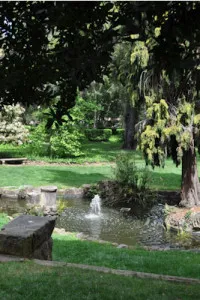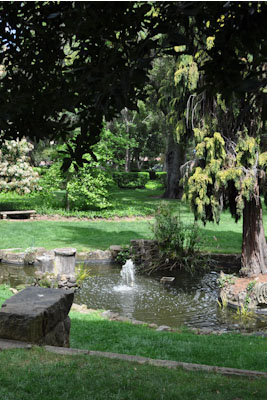From every point in the garden, you can see it in its entirety. Small stone steps overlook two quiet ponds spanned by a little bridge, framed and sheltered by evergreens, hedges and tulip trees. It is sparse and miniature in scope, with enough bench space for only two people tucked underneath the greenery. Looking down the grassy hill from the bench, one can see a slightly old-fashioned apartment building, Kingscote Gardens.
Its occupants–mostly graduate students–sporadically trickle out of the building, but for the most part, the whole area remains hidden from campus life. Despite its location at the heart of campus, between Tresidder Union and Lomita Drive, very few people have heard of the place, and it barely features in literature about Stanford’s history and architecture.
The unassuming building, tall hedges and concave curve of the garden successfully hide Kingscote from the masses of students pouring out of the nearby campus hotspots. The dull roar of passing cars is barely perceptible over the sound of the fountain.
“Psychologically, people might feel uncomfortable coming here, because it looks like a very intimate space, something too private, in which they might feel too vulnerable,” said Robert Harrison, professor of Italian literature.
Harrison himself didn’t start paying attention to Kingscote until he started writing his book, “Gardens: An Essay on the Human Condition.” Since then, however, he has frequented the garden and “adopted,” in his own words, this little nook of Stanford.
“There is a guarded but also inviting element [to the garden],” Harrison said. Commenting on a pair of ducks that frequents the ponds, he noted that the garden “invites life into it.” And despite the garden’s sense of enclosure, in his book Harrison characterizes its boundaries as “porous, even promiscuous.”

While no public or University records are available to identify the garden’s designer, the origin of the building is clear. In 1915, Sarah Howard, widow of Stanford Political Science Professor Burt Howard, approached University President Ray Lyman Wilbur with a proposal to develop an apartment to house visiting professors. In 1917, a year after Wilbur approved the proposal, Kingscote Gardens opened its doors to guests.
For 80 years, the Howard Holding Company owned and managed the property until the Howard family lease expired in the mid-1990s and the property was returned to the University.
While the gardens have, for the most part, remained unchanged since their construction, their quiet presence served as the backdrop for significant moments in history. The students who live at Kingscote today rent rooms once occupied by visitors from across the world–accomplished professors, high-ranking politicians and famous novelists.
Charles Beardsley wrote his 1974 novel “The Apartments” during his stay at Kingscote Gardens. The novel’s fictitious Kumquat Gardens bear a resemblance to Kingscote, but Beardsley denied any connection.
The once secretive presence of important figures speaks to the mystique of Kingscote. Despite its humble appearance, its list of former guests is surprising and impressive.
Romanian diplomat George I. Duca, who was instrumental in determining Romania’s role in World War II, split his time at Stanford between the apartments and the classroom, where he taught history and political science courses. According to a 1987 Daily article (“A place in the sun,” April 22, 1987), Duca was the favorite guest of the manager of Kingscote Gardens at the time.
Bruce Bliven, former editor of The New Republic, spent his last years living quietly at Kingscote, after a career that took him on adventures exposing military prisons and meeting secretly with underground groups in Cuba.
“[The garden] seems like a bit of an asylum away from politics,” Harrison said.
For a figure such as Alexander Kerensky, the secluded yet inviting nature of the complex provided a perfect haven from a tumultuous political career. Kerensky came to the forefront of the Russian Revolution when he headed the provisional government established between the February and October revolutions of 1917.
“He was a very capable politician and sensed opportunities better than other politicians,” said Amir Weiner, associate professor of history.
As a moderate socialist, Kerensky pushed for many social reforms and made significant progress in establishing universal suffrage and the abolishment of censorship. However, according to Weiner, the consensus of historians is that from the outset, the circumstances conflicted with his centrist and socially progressive views and set up the failure of his government. This was why, after leaving Russia, he eventually found his way to Palo Alto.
“He had to deal with tremendous pressure from both left and right,” Weiner said. “The problem was that there was no time or patience.”
After his stance on a number of issues left him without a power base, Kerensky fled for his life as the radical Bolsheviks took power. Kerensky came to Stanford in 1955 to consult the Hoover Archives to help him write his memoirs. He soon settled into a room on the upper floor of Kingscote. While completing his memoirs, he taught classes based on his political experience.
In many ways, Kerensky’s personality seems incongruous with the unassuming nature of Kingscote.
“He had a sense of flamboyance which was good for a time of revolution but also made him a bit too much of an egomaniac,” Weiner said.
This personality carried over to his days at Stanford.
“He was very confident as always, a ‘ladies man’ who liked good company and enjoyed a good Russian gathering,” Weiner said.
Nevertheless, the inconspicuous peace of Kingscote is a fitting conclusion to Kerensky’s volatile life, reflecting his retreat from the political scene.
“In 1941, Kerensky gave many supportive speeches for the Russian [war] cause, but by this time he [was] a nobody,” Weiner said. “His relevance to the political arena having diminished, he frequented these quiet gardens in the last years of his life.”
Harrison speculated that the gardens perhaps served a deeper, ideological role for figures such as Kerensky.
“According to Czech writer Karel Capek, there is a natural connection between the democratic political form and gardens,” Harrison said.
Gardens, he continued, need to be tended to by people in the same way that citizens are caretakers of a democratic state. Such a garden as Kingscote would have provided a poetic backdrop to Kerensky’s ideals of achieving social change through moderate and democratic means. One can perhaps imagine such a person in this recess, contemplating his ideology around the shaded ponds.
The garden seems to be engineered to act as a sanctuary for these illustrious figures. The shade and serene environment serve as perfect contrast to the violent fervor of historical change and revolution.
“There is a remoteness created by the shape of the garden,” Harrison said. “It dampens the excessive presence of what is beyond its boundaries.”
